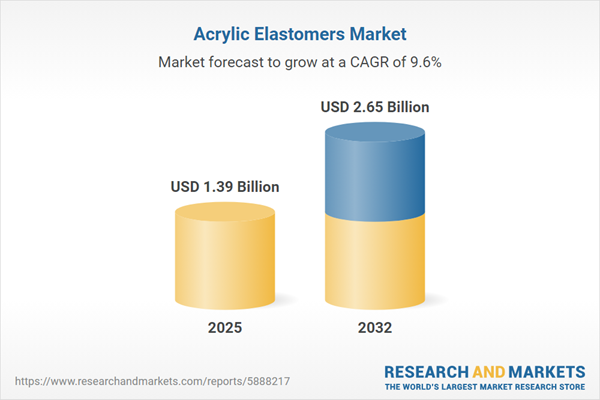Speak directly to the analyst to clarify any post sales queries you may have.
The acrylic elastomers market is experiencing rapid evolution as regulatory changes and advanced manufacturing technologies reshape procurement and operational strategies. Senior decision-makers are focusing on agile sourcing, product innovation, and compliance to secure long-term competitiveness within this dynamic industrial segment.
Acrylic Elastomers Market Snapshot
The acrylic elastomers market is forecasted to expand from USD 1.27 billion in 2024 to USD 1.39 billion by 2025, representing a 9.63% CAGR. This growth is propelled by ongoing demand for high-performance materials with enhanced durability and chemical resistance, especially across sectors such as automotive and construction. Market leaders are adapting by streamlining supply chains and investing in next-generation compounds to deliver products that meet rigorous, industry-specific criteria. Strategic focus on these areas enables organizations to respond quickly to changing compliance landscapes and capture value in both established and emerging verticals.
Acrylic Elastomers Market Scope & Segmentation
Comprehensive segmentation supports executive decision-making by highlighting product diversity, technological adoption, and regional market dynamics. This approach helps align organizational resources while ensuring compatibility with evolving standards and customer expectations. Segmentation scope includes:
- Product Types: Butadiene Methyl Methacrylate Copolymers, Ethyl Methyl Acrylate Copolymers, Methyl Methacrylate Copolymers. Each addresses specific environmental and mechanical requirements, allowing for tailored selection based on desired resilience and chemical stability.
- Applications: Pressure Sensitive Adhesives, Sealants, Structural Adhesives, Automotive Gaskets, Hoses, Seals, Construction Flooring, Waterproofing Membranes, Industrial Belts, O Rings, Coatings. These enable consistent performance in critical infrastructure and manufacturing settings, where longevity and reliability are valued.
- End Use Industries: Aerospace, Automotive, Construction, Electronics, Medical, Oil & Gas. Distinct compliance and investment priorities in these sectors drive continued innovation and higher standards for material testing and sourcing.
- Form Factors: Granules, Latex, Liquid. These formats optimize material compatibility with a range of manufacturing processes, promoting scalability and process efficiency at both large and precision volumes.
- Sales Channels: Direct Sales, Distributor Networks. Market participants select routes for regulatory adaptability and responsive service capabilities tailored to regional requirements.
- Regional Coverage: Americas, Europe, Middle East, Africa, Asia-Pacific. Diverse partnership structures and certification pressures in these regions shape strategic entries, affecting adoption rates and supplier alignment.
- Key Industry Players: Arkema S.A., Dow Inc., BASF SE, Evonik Industries AG, The Lubrizol Corporation, Celanese Corporation, Zeon Corporation, Wacker Chemie AG, Kuraray Co., Ltd., Mitsubishi Chemical Corporation. These organizations influence technology trajectories and global distribution models.
Leveraging this segmentation ensures effective allocation of resources across technology development, regulatory compliance, and supply chain partnerships—aligning operational focus with long-term growth prospects.
Acrylic Elastomers Market: Key Takeaways for Senior Decision-Makers
- Bio-based and recycled acrylic elastomers gain traction as organizations seek sustainability while complying with operational standards and reducing long-term environmental exposure.
- Digital automation advances help streamline processes, reinforcing quality control systems and aligning plants with shifting compliance requirements.
- Rising demand for formulations with greater chemical resistance supports reliability for mission-critical components in automotive and medical sectors, where material failure poses risk.
- Investments in flexible and resilient sourcing help reduce the operational impact of global supply disruptions, currency volatility, and changing trade environments.
- Regional procurement models allow for tailored certification responses and swift adaptation to diverse regulatory scenarios, offering risk mitigation for multinational organizations.
Tariff Impact and Supply Chain Realignment
Evolving tariff policies are prompting companies to localize procurement for high-performance uses such as adhesives and sealants. This transition enables closer regulatory oversight and stabilizes material availability, especially under uncertain trade conditions. Organizations increasingly deploy flexible sourcing and inventory management tools to buffer against volatility and extend their supplier networks. Progress in elastomer formulations further broadens sourcing possibilities, supporting continuity as compliance and trade environments shift.
Methodology & Data Sources
Report findings are grounded in insights from materials scientists, procurement executives, and OEM experts. Analysis draws from technical literature, compliance databases, vendor evaluations, and scenario-driven strategy assessments, ensuring a reliable foundation for executive planning.
Why This Report Matters
- Delivers segmentation frameworks to guide procurement strategy and reinforce resilient supply chain operations in volatile markets.
- Enables leadership teams to anticipate regulatory changes, mitigate disruption risks, and benchmark progress in elastomer innovation.
- Supports investment confidence and responsible, forward-looking operational shifts in response to evolving business drivers.
Conclusion
Prioritizing innovation, compliance, and agile sourcing positions organizations to adapt and succeed in the changing acrylic elastomers market. Proactive management of these areas supports sustainable, resilient growth and continuous industry leadership.
Additional Product Information:
- Purchase of this report includes 1 year online access with quarterly updates.
- This report can be updated on request. Please contact our Customer Experience team using the Ask a Question widget on our website.
Table of Contents
3. Executive Summary
4. Market Overview
7. Cumulative Impact of Artificial Intelligence 2025
Companies Mentioned
The companies profiled in this Acrylic Elastomers market report include:- Arkema S.A.
- Dow Inc.
- BASF SE
- Evonik Industries AG
- The Lubrizol Corporation
- Celanese Corporation
- Zeon Corporation
- Wacker Chemie AG
- Kuraray Co., Ltd.
- Mitsubishi Chemical Corporation
Table Information
| Report Attribute | Details |
|---|---|
| No. of Pages | 197 |
| Published | November 2025 |
| Forecast Period | 2025 - 2032 |
| Estimated Market Value ( USD | $ 1.39 Billion |
| Forecasted Market Value ( USD | $ 2.65 Billion |
| Compound Annual Growth Rate | 9.6% |
| Regions Covered | Global |
| No. of Companies Mentioned | 11 |









